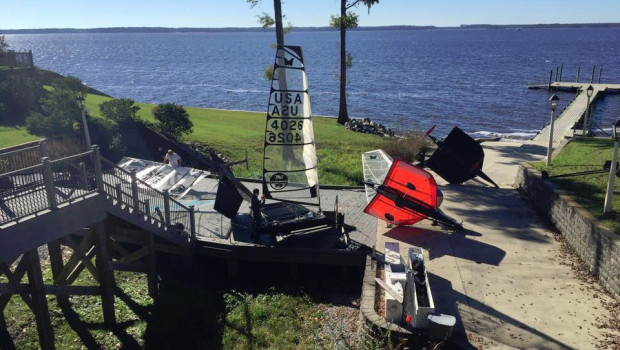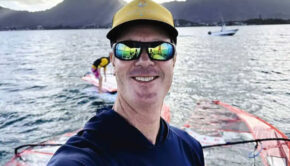The US Garage Band vs. The World
Published on November 22nd, 2015
by Chris Museler
“OK, someone has to take a picture and send it to our hosts as a thank you gift,” shouted Anthony Kotoun, the Dali Lama of the US Moth fleet at dinner a few nights ago. “Then we have to shanghai Zack Maxim’s boat from the shipping company. There’s a $200 prize for anyone willing to wake up at 6 a.m. tomorrow for the 1.18-hour drive…” And the list rolled on that way until our beers and grilled oysters were delivered.
It was a pretty spendy call in November to take a week from work and family and head to the Neuse River in North Carolina for a training session in the outrageously quick and touchy Moth. The US fleet was offered rooms and a launch at Steve and Heidi Benjamin’s compound on this enormous estuary of brackish water and oyster fishermen.
The major selling point? A $10,000 prize, of course! Amlin International Moth Regatta in December has hand-selected the best sailors in the world to bring their personal, single-handed boats to Bermuda and race for not only a prize purse but bragging rights.
You see, all the top America’s Cup teams (with the highest paid sailors on the planet) have fleets of Moths for their sailors to train with. And the Royal Yachting Association has sponsored elite Mothies from the UK for a few years now to top this influential class. They all want to beat the crap out of each other on their own terms, with their own boats. Trimmers wanting to take races off their Cup helmsmen, etc.
Then there are the Americans, layered in wetsuits during the camp, getting ripped off their trampolines and hucked into the brown water of the Intercoastal Waterway when the chop would pitch the boats while they were hitting 30 knots.
Strangely absent from many of the Cup teams, and only supported by the environmentally forward thinking 11th Hour Racing, this group of pro and amateur sailors have been covered in carbon dust and resin every week for the past season adjusting, designing, 3-D printing and training their way toward their goal of out sailing the privileged group in Bermuda.
This was my chance to witness how the DIY approach to boat work and training can get someone ready to beat the most well paid, and funded, teams in the world. Very American!
The routine has been the same for this group since the frigid mornings of last April in Newport (RI), the fleet’s summer home. Boat work at night and hours of training during the day to test new systems. North Carolina was a hyper-focused version of this system.
Typical was the night when, Nat Shaver, who designed foils for Team New Zealand in the last Cup and is now working with the French Cup Team, was jamming on one of his many carbon fixes since the training camp began.”It’ll be so shitty and ugly,” he said, after using a dremel to grind off the broken bits at the end of his homemade boom, “but it’ll do the job, I think.”
Moth sailors in America easily spend 70 percent of their time on boat work in this development class and barely the remaining 30 on the water. The base structure of the boats is the Mach 2 Moth built by McConaghy in China.
Why do the boats need so much work? Foiling sailboats are still new, at the boundaries of the sport and when you are traveling upwind at 16-17 knots and downwind at 20-30, the most minute adjustment can make many knots-worth of difference. So the short answer is: systems.
Making carbon levers to articulate and assist canting the rig from side to side, gluing little tabs to anchor sail adjustment pulleys (some so tiny they are sourced from remote control boat manufacturers) and repairing the constantly breaking modifications to the carbon wing bars and booms are added to work lists daily, attended to at night, and tested the next day.
The Americans are their own pit crews and coaches. And they want to kick ass next month. Jamestown Distributors president Mike Mills, a foil boarder himself, saw an awesome parallel between what this group is doing and what he was part of in the late 1990s in the International 505 class, easily the most elite double handed class in the world. Mike won the worlds in 1998 with Nick Trotmen after years of this very organic approach. JD sent me down with boxes of their house brand Total Boat epoxies and supplies to support the group.
Asking around, I realized that literally all the top performance sailors in the US, all plugging away in their garages to modify and repair their boats, use JD and the growing line of Total Boat products, especially the epoxies and fibers.
And when you do everything yourself, and pay out of your own pocket to make your boat faster, knowing there is a company that understands and gets you what you need STAT, makes a huge difference.
I’ll report back on how it all went with the work lists, which fixes worked, which didn’t and if this rag-tag group of rouge sailors will be ready to dethrone a few of those fully-sponsored pros in Bermuda next month.
Source: TFW









 We’ll keep your information safe.
We’ll keep your information safe.